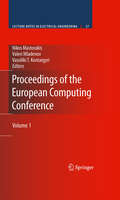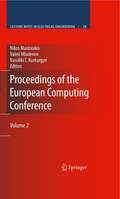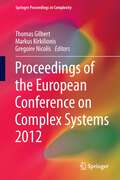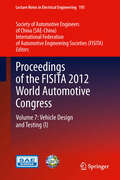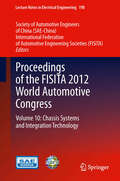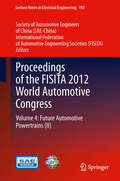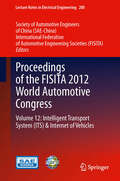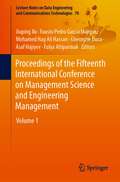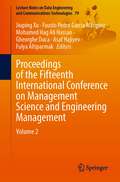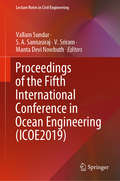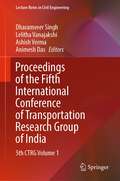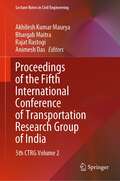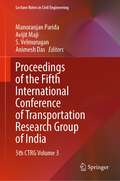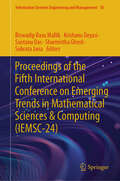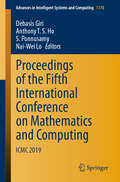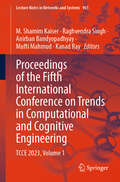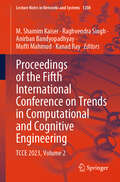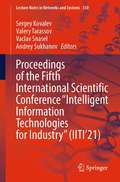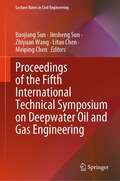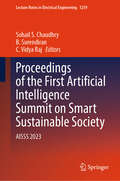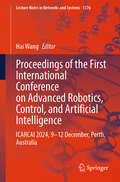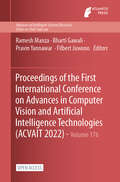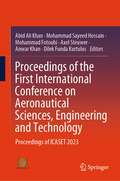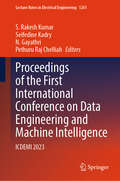- Table View
- List View
Proceedings of the European Computing Conference: Volume 1
by Nikos Mastorakis Vassiliki T. Kontargyri Valeri MladenovThe European Computing Conference offers a unique forum for establishing new collaborations within present or upcoming research projects, exchanging useful ideas, presenting recent research results, participating in discussions and establishing new academic collaborations, linking university with the industry. Engineers and Scientists working on various areas of Systems Theory, Applied Mathematics, Simulation, Numerical and Computational Methods and Parallel Computing present the latest findings, advances, and current trends on a wide range of topics. This proceedings volume will be of interest to students, researchers, and practicing engineers.
Proceedings of the European Computing Conference: Volume 2
by Nikos Mastorakis Vassiliki T. Kontargyri Valeri MladenovThe European Computing Conference offers a unique forum for establishing new collaborations within present or upcoming research projects, exchanging useful ideas, presenting recent research results, participating in discussions and establishing new academic collaborations, linking university with the industry. Engineers and Scientists working on various areas of Systems Theory, Applied Mathematics, Simulation, Numerical and Computational Methods and Parallel Computing present the latest findings, advances, and current trends on a wide range of topics. This proceedings volume will be of interest to students, researchers, and practicing engineers.
Proceedings of the European Conference on Complex Systems 2012
by Gregoire Nicolis Markus Kirkilionis Thomas GilbertThe European Conference on Complex Systems, held under the patronage of the Complex Systems Society, is an annual event that has become the leading European conference devoted to complexity science. ECCS'12, its ninth edition, took place in Brussels, during the first week of September 2012. It gathered about 650 scholars representing a wide range of topics relating to complex systems research, with emphasis on interdisciplinary approaches. More specifically, the following tracks were covered: 1. Foundations of Complex Systems 2. Complexity, Information and Computation 3. Prediction, Policy and Planning, Environment 4. Biological Complexity 5. Interacting Populations, Collective Behavior 6. Social Systems, Economics and Finance This book contains a selection of the contributions presented at the conference and its satellite meetings. Its contents reflect the extent, diversity and richness of research areas in the field, both fundamental and applied.
Proceedings of the FISITA 2012 World Automotive Congress
by Sae-China FisitaProceedings of the FISITA 2012 World Automotive Congress are selected from nearly 2,000 papers submitted to the 34th FISITA World Automotive Congress, which is held by Society of Automotive Engineers of China (SAE-China ) and the International Federation of Automotive Engineering Societies (FISITA). This proceedings focus on solutions for sustainable mobility in all areas of passenger car, truck and bus transportation. Volume 2: Advanced Internal Combustion Engines (II) focuses on: •Flow and Combustion Diagnosis •Engine Design and Simulation •Heat Transfer and Waste Heat Reutilization •Emission Standard and International Regulations Above all researchers, professional engineers and graduates in fields of automotive engineering, mechanical engineering and electronic engineering will benefit from this book. SAE-China is a national academic organization composed of enterprises and professionals who focus on research, design and education in the fields of automotive and related industries. FISITA is the umbrella organization for the national automotive societies in 37 countries around the world. It was founded in Paris in 1948 with the purpose of bringing engineers from around the world together in a spirit of cooperation to share ideas and advance the technological development of the automobile.
Proceedings of the FISITA 2012 World Automotive Congress: Advanced Vehicle Manufacturing Technology
by Sae-China FisitaProceedings of the FISITA 2012 World Automotive Congress are selected from nearly 2,000 papers submitted to the 34th FISITA World Automotive Congress, which is held by Society of Automotive Engineers of China (SAE-China ) and the International Federation of Automotive Engineering Societies (FISITA). This proceedings focus on solutions for sustainable mobility in all areas of passenger car, truck and bus transportation. Volume 11: Advanced Vehicle Manufacturing Technology focuses on: •Applications of Aluminum, Magnesium and Zink Alloys , Composites •Advanced Body Manufacturing Technology •Body Corrosion Protection Technology •Welding, Joining and Fastening •Casting Technology •Stamping Technology •Paints, Polymers and Coatings •Exterior Body Panels •Advanced Process Management Above all researchers, professional engineers and graduates in fields of automotive engineering, mechanical engineering and electronic engineering will benefit from this book. SAE-China is a national academic organization composed of enterprises and professionals who focus on research, design and education in the fields of automotive and related industries. FISITA is the umbrella organization for the national automotive societies in 37 countries around the world. It was founded in Paris in 1948 with the purpose of bringing engineers from around the world together in a spirit of cooperation to share ideas and advance the technological development of the automobile.
Proceedings of the FISITA 2012 World Automotive Congress: Chassis Systems and Integration Technology
by Sae-China FisitaProceedings of the FISITA 2012 World Automotive Congress are selected from nearly 2,000 papers submitted to the 34th FISITA World Automotive Congress, which is held by Society of Automotive Engineers of China (SAE-China) and the International Federation of Automotive Engineering Societies (FISITA). This proceedings focus on solutions for sustainable mobility in all areas of passenger car, truck and bus transportation. Volume 10: Chassis Systems and Integration Technology focuses on: •Chassis structure and Design •Chassis Controls and Integration •Tire and wheel Design/ Tire Properties and Modeling •Subjective and Objective Evaluation on Dynamic Performance •Dynamics Modeling, Simulation and Experimental Validation Above all researchers, professional engineers and graduates in fields of automotive engineering, mechanical engineering and electronic engineering will benefit from this book. SAE-China is a national academic organization composed of enterprises and professionals who focus on research, design and education in the fields of automotive and related industries. FISITA is the umbrella organization for the national automotive societies in 37 countries around the world. It was founded in Paris in 1948 with the purpose of bringing engineers from around the world together in a spirit of cooperation to share ideas and advance the technological development of the automobile.
Proceedings of the FISITA 2012 World Automotive Congress: Future Automotive Powertrains (II)
by Sae-China FisitaProceedings of the FISITA 2012 World Automotive Congress are selected from nearly 2,000 papers submitted to the 34th FISITA World Automotive Congress, which is held by Society of Automotive Engineers of China (SAE-China ) and the International Federation of Automotive Engineering Societies (FISITA). This proceedings focus on solutions for sustainable mobility in all areas of passenger car, truck and bus transportation. Volume 4: Future Automotive Powertrain (II) focuses on: *Advanced Battery Technology *Hydrogen Fuel Cell Vehicle *Charging Infrastructure and Smart Grid Technology *Demonstration of Electric Vehicles in Cities Above all researchers, professional engineers and graduates in fields of automotive engineering, mechanical engineering and electronic engineering will benefit from this book. SAE-China is a national academic organization composed of enterprises and professionals who focus on research, design and education in the fields of automotive and related industries. FISITA is the umbrella organization for the national automotive societies in 37 countries around the world. It was founded in Paris in 1948 with the purpose of bringing engineers from around the world together in a spirit of cooperation to share ideas and advance the technological development of the automobile.
Proceedings of the FISITA 2012 World Automotive Congress: Intelligent Transport System(ITS) & Internet of Vehicles
by Sae-China FisitaProceedings of the FISITA 2012 World Automotive Congress are selected from nearly 2,000 papers submitted to the 34th FISITA World Automotive Congress, which is held by Society of Automotive Engineers of China (SAE-China ) and the International Federation of Automotive Engineering Societies (FISITA). This proceedings focus on solutions for sustainable mobility in all areas of passenger car, truck and bus transportation. Volume 12: Intelligent Transport System (ITS)& Internet of Vehicles focuses on: •Driver Assistance System •V2X Communication Technology •Telematics and Navigation Systems •Eco Driving Technology •Harmonization and Regulation of ITS Systems Above all researchers, professional engineers and graduates in fields of automotive engineering, mechanical engineering and electronic engineering will benefit from this book. SAE-China is a national academic organization composed of enterprises and professionals who focus on research, design and education in the fields of automotive and related industries. FISITA is the umbrella organization for the national automotive societies in 37 countries around the world. It was founded in Paris in 1948 with the purpose of bringing engineers from around the world together in a spirit of cooperation to share ideas and advance the technological development of the automobile.
Proceedings of the Fifteenth International Conference on Management Science and Engineering Management: Volume 1 (Lecture Notes on Data Engineering and Communications Technologies #78)
by Fausto Pedro García Márquez Jiuping Xu Gheorghe Duca Asaf Hajiyev Mohamed Hag Ali Hassan Fulya AltiparmakThis book gathers the proceedings of the fifteenth International Conference on Management Science and Engineering Management (ICMSEM 2021) held on August 1-4, 2021, at the University of Castilla-La Mancha (UCLM), Toledo, Spain. The proceedings contains theoretical and practical research of decision support systems, complex systems, empirical studies, sustainable development, project management, and operation optimization, showing advanced management concepts and demonstrates substantial interdisciplinary developments in MSEM methods and practical applications. It allows researchers and practitioners in management science and engineering management (MSEM) to share their latest insights and contribution. Meanwhile, it appeals to readers interested in these areas, especially those looking for new ideas and research directions.
Proceedings of the Fifteenth International Conference on Management Science and Engineering Management: Volume 2 (Lecture Notes on Data Engineering and Communications Technologies #79)
by Fausto Pedro García Márquez Jiuping Xu Gheorghe Duca Asaf Hajiyev Mohamed Hag Ali Hassan Fulya AltiparmakThis book gathers the proceedings of the fifteenth International Conference on Management Science and Engineering Management (ICMSEM 2021) held on August 1-4, 2021, at the University of Castilla-La Mancha (UCLM), Toledo, Spain. The proceedings contains theoretical and practical research of decision support systems, complex systems, empirical studies, sustainable development, project management, and operation optimization, showing advanced management concepts and demonstrates substantial interdisciplinary developments in MSEM methods and practical applications. It allows researchers and practitioners in management science and engineering management (MSEM) to share their latest insights and contribution. Meanwhile, it appeals to readers interested in these areas, especially those looking for new ideas and research directions.
Proceedings of the Fifth International Conference in Ocean Engineering (Lecture Notes in Civil Engineering #106)
by V. Sriram Vallam Sundar S. A. Sannasiraj Manta Devi NowbuthThis book comprises the proceedings of the Fifth International Conference in Ocean Engineering (ICOE2019) focusing on emerging opportunities and challenges in the field of ocean engineering and offshore structures. Some of the themes covered in this volume are offshore structures and deepwater technology, ocean optics & acoustics, ocean renewable energy, marine spatial planning, climate change impacts & disaster risk reduction, etc. The essays are written by leading international experts, making it a valuable resource for researchers and practicing engineers alike.
Proceedings of the Fifth International Conference of Transportation Research Group of India: 5th CTRG Volume 1 (Lecture Notes in Civil Engineering #218)
by Animesh Das Ashish Verma Dharamveer Singh Lelitha VanajakshiThis book (in three volumes) comprises the proceedings of the Fifth Conference of Transportation Research Group of India (CTRG2019) focusing on emerging opportunities and challenges in the field of transportation of people and freight. The contents of the book include characterization of conventional and innovative pavement materials, operational effects of road geometry, user impact of multimodal transport projects, spatial analysis of travel patterns, socio-economic impacts of transport projects, analysis of transportation policy and planning for safety and security, technology-enabled models of mobility services, etc. This book will be beneficial to researchers, educators, practitioners and policymakers alike.
Proceedings of the Fifth International Conference of Transportation Research Group of India: 5th CTRG Volume 2 (Lecture Notes in Civil Engineering #219)
by Animesh Das Akhilesh Kumar Maurya Bhargab Maitra Rajat RastogiThis book (in three volumes) comprises the proceedings of the Fifth Conference of Transportation Research Group of India (CTRG2019) focusing on emerging opportunities and challenges in the field of transportation of people and freight. The contents of the volume include characterization of conventional and innovative pavement materials, operational effects of road geometry, user impact of multimodal transport projects, spatial analysis of travel patterns, socio-economic impacts of transport projects, analysis of transportation policy and planning for safety and security, technology enabled models of mobility services, etc. This book will be beneficial to researchers, educators, practitioners and policy makers alike.
Proceedings of the Fifth International Conference of Transportation Research Group of India: 5th CTRG Volume 3 (Lecture Notes in Civil Engineering #220)
by Animesh Das S. Velmurugan Manoranjan Parida Avijit MajiThis book (in three volumes) comprises the proceedings of the Fifth Conference of Transportation Research Group of India (CTRG2019) focusing on emerging opportunities and challenges in the field of transportation of people and freight. The contents of the volume include characterization of conventional and innovative pavement materials, operational effects of road geometry, user impact of multimodal transport projects, spatial analysis of travel patterns, socio-economic impacts of transport projects, analysis of transportation policy and planning for safety and security, technology enabled models of mobility services, etc. This book will be beneficial to researchers, educators, practitioners and policy makers alike.
Proceedings of the Fifth International Conference on Emerging Trends in Mathematical Sciences & Computing (Information Systems Engineering and Management #10)
by Santanu Das Subrata Jana Sharmistha Ghosh Krishanu Deyasi Biswadip Basu MallikThe Proceedings of the Fifth International Conference on Emerging Trends in Mathematical Sciences & Computing (IEMSC-24) contains papers that present the current scientific as well as technological innovations by leading academicians, eminent researchers, and experts throughout the globe in the twin domain of Mathematical Sciences as well as Computing. The papers focus on the recent advances in the field of Theoretical Computer Science as well as its blending with Mathematical techniques. The book aims to disseminate new technical ideas and features that can be incorporated in day-to-day life for the benefit of the society. The research papers exhibit scientific advancements in diversified spectrum that includes Differential as well as Integral Equations with applications, Computational Fluid Dynamics, Nanofluids, Network Theory & Optimization, Control Theory, Machine Learning & Artificial Intelligence, Big Data Analytics, IoT, Cryptography, Fuzzy Automata, Statistics, and many more. The proceedings primarily focus on the amalgamation of mathematical methods with computing. The potential readers will get access to diverse ideas and innovations in the field of computing together with its growing interactions in various fields of mathematics. This book serves as a valuable reference resource for researchers in academia and industry.
Proceedings of the Fifth International Conference on Mathematics and Computing: ICMC 2019 (Advances in Intelligent Systems and Computing #1170)
by S. Ponnusamy Debasis Giri Anthony T. S. Ho Nai-Wei LoThis book features selected papers from the 5th International Conference on Mathematics and Computing (ICMC 2019), organized by the School of Computer Engineering, Kalinga Institute of Industrial Technology Bhubaneswar, India, on February 6 – 9, 2019. Covering recent advances in the field of mathematics, statistics and scientific computing, the book presents innovative work by leading academics, researchers and experts from industry.
Proceedings of the Fifth International Conference on Trends in Computational and Cognitive Engineering: TCCE 2023, Volume 1 (Lecture Notes in Networks and Systems #961)
by Kanad Ray Anirban Bandyopadhyay Mufti Mahmud M. Shamim Kaiser Raghvendra SinghThis book presents various computational and cognitive modeling approaches in the areas of health, education, finance, environment, engineering, commerce and industry. It is a collection of selected conference papers presented at the 5th International Conference on Trends in Cognitive Computation Engineering (TCCE 2023), organized by Pranveer Singh Institute of Technology, Kanpur Uttar Pradesh, India in collaboration with IIOIR, Shimla, Himachal Pradesh, India, during 24 – 25 November 2023. The book is divided into two volumes, and it shares cutting-edge insights and ideas from mathematicians, engineers, scientists, and researchers and discusses fresh perspectives on problem solving in a range of research areas.
Proceedings of the Fifth International Conference on Trends in Computational and Cognitive Engineering: TCCE 2023, Volume 2 (Lecture Notes in Networks and Systems #1208)
by Kanad Ray Anirban Bandyopadhyay Mufti Mahmud M. Shamim Kaiser Raghvendra SinghThis book presents various computational and cognitive modeling approaches in the areas of health, education, finance, environment, engineering, commerce and industry. It is a collection of selected conference papers presented at the 5th International Conference on Trends in Cognitive Computation Engineering (TCCE 2023), organized by Pranveer Singh Institute of Technology, Kanpur Uttar Pradesh, India in collaboration with IIOIR, Shimla, Himachal Pradesh, India, during 24 – 25 November 2023. The book is divided into two volumes, and it shares cutting-edge insights and ideas from mathematicians, engineers, scientists, and researchers and discusses fresh perspectives on problem solving in a range of research areas.
Proceedings of the Fifth International Scientific Conference “Intelligent Information Technologies for Industry” (Lecture Notes in Networks and Systems #330)
by Vaclav Snasel Sergey Kovalev Valery Tarassov Andrey SukhanovThis book presents key advances in intelligent information technologies for industry. This book of Lecture Notes in Networks and Systems contains the papers presented in the main track of IITI 2021, the Fifth International Scientific Conference on Intelligent Information Technologies for Industry held on September 30 – October 4, 2021 in Sirius, Russia. The conference was jointly co-organized by Rostov State Transport University (Russia) and VŠB–Technical University of Ostrava (Czech Republic) with the participation of Russian Association for Artificial Intelligence (RAAI) and Sirius University (Russia).IITI 2021 was devoted to practical models and industrial applications related to intelligent information systems. It was considered as a meeting point for researchers and practitioners to enable the implementation of advanced information technologies into various industries. Nevertheless, some theoretical talks concerning the state of the art in intelligent systems and soft computing were also included into proceedings.There were 180 paper submissions from 14 countries. Each submission was reviewed by at least three chairs or PC members. We accepted 69 regular papers (38\%). Unfortunately, due to limitations of conference topics and edited volumes, the Program Committee was forced to reject some interesting papers, which did not satisfy these topics or publisher requirements. We would like to thank all authors and reviewers for their work and valuable contributions. The friendly and welcoming attitude of conference supporters and contributors made this event a success!
Proceedings of the Fifth International Technical Symposium on Deepwater Oil and Gas Engineering (Lecture Notes in Civil Engineering #472)
by Baojiang Sun Zhiyuan Wang Jinsheng Sun Litao Chen Meiping ChenThis book is a compilation of selected papers from the Fifth International Technical Symposium on Deepwater Oil and Gas Engineering and the Fourth International Youth Forum on Gas Hydrate (DWOG-Hyd 2023), held in Qingdao, China, in October 2023. The book focuses on the advancement of techniques for the deepwater oil and gas exploitation and natural gas hydrate exploitation. The book introduces new ideas for exploring deepwater oil, gas and hydrate in a safe and efficient way. Advances of the deepwater oil, gas and hydrate drilling and production in South China Sea, in oil and gas flow assurance and emerging technologies based on clathrate hydrate will be presented. It is a valuable resource for both practitioners and academics working in the field of deepwater oil and gas engineering.
Proceedings of the First Artificial Intelligence Summit on Smart Sustainable Society: AISSS 2023 (Lecture Notes in Electrical Engineering #1259)
by Sohail S. Chaudhry B. Surendiran C. Vidya RajThe book includes proceedings of AI Summit 2023: Towards a Smart Sustainable Society which serve as a collaborative platform for diverse communities to address and resolve societal challenges using Artificial Intelligence. This book enables experts and researchers to evaluate the advantages of AI-driven technological transformations. It covers an extensive array of topics in artificial intelligence and machine learning, including deep learning, image processing, convolutional neural networks, advanced neural networks, sensors, Internet of Things (IoT), and genetic algorithms.
Proceedings of the First International Conference on Advanced Robotics, Control, and Artificial Intelligence: ICARCAI 2024, 9–12 December, Perth, Australia (Lecture Notes in Networks and Systems #1376)
by Hai WangThis book highlights the latest research developments and outcomes on all aspects of advanced robotics, control and artificial intelligence. Particularly, it not only includes those emerging methodologies and techniques which bridge theoretical studies and applications in all robotics and control systems as well as artificial intelligence, but also involves the practical concerns and challenges encountered and potential solutions in those fields.
Proceedings of the First International Conference on Advances in Computer Vision and Artificial Intelligence Technologies (Advances in Intelligent Systems Research #176)
by Bharti Gawali Ramesh Manza Pravin Yannawar Filbert JuwonoThis is an open access book.The first international Conference on Advances in Computer Vision and Artificial Intelligence Technologies (ACVAIT 2022) is a biennial conference organized by Department of Computer Science and Information Technology, Dr. Babasaheb Ambedkar Marathwada University, Aurangabad (MS) India, during August 1–2, 2022. ACVAIT 2022, is dedicated towards advances in the theme areas of Computer Vision, Image Processing, Pattern Recognition, Artificial Intelligence, Machine Learning, Human Computer Interactions, Biomedical Image Processing, Geospatial Technology, Hyperspectral image processing and allied technologies but not limited to. ACVAIT 2022, invites young and/or advanced researchers contributing in the theme area of the conference and also provide them platform for discussing their scientific contributions / research findings with the domain experts, exchange ideas with them and foster closer collaboration between members from the top universities / Higher Education Institutes (HEI). ACVAIT 2022, inviting domain specific work from research scholars, academician, machine learning & AI scientist, industry experts to contribute their scientific contribution in the following areas but not limited to.• Shape representation• Biometrics: face matching, iris recognition, footprint verification and many more.• Statistical, Structural and syntactic pattern recognition• Brain Computer Interface and Human Computer Interactions• Feature extraction and reduction• Biomedical Image Processing• Color and texture analysis• Speech analysis and understanding• Image segmentation• Speaker verification & Synthesis• Image compression, coding and encryption• Clustering and classification• Object recognition, scene understanding and video analytics• Machine learning algorithms • Image matching (pattern matching)• Extreme learning machine• Content based image retrieval and indexing• Artificial Intelligence Trends in Deep learning• Optical character recognition• Big data• Image & Video Forensics• Information retrieval• Pattern recognition and machine learning for Internet of Things• Data mining and Data Analytics• Pattern classification through Sensors• Pattern Recognition for Hyper Spectral Imaging• Satellite Image Processing
Proceedings of the First International Conference on Aeronautical Sciences, Engineering and Technology: Proceedings of ICASET 2023
by Anwar Khan Abid Ali Khan Mohammad Sayeed Hossain Mohammad Fotouhi Axel Steuwer Dilek Funda KurtulusThis volume contains forty-one revised and extended research articles, written by prominent researchers participating in the International Conference on Aeronautical Sciences, Engineering and Technology 2023, held in Muscat, October 3-5 2023. It focuses on the latest research developments in aeronautical applications, avionics systems, advanced aerodynamics, atmospheric chemistry, emerging technologies, safety management, unmanned aerial vehicles, and industrial applications. This book offers the state of the art of notable advances in engineering technologies and aviation applications and serves as an excellent source of reference for researchers and graduate students.
Proceedings of the First International Conference on Data Engineering and Machine Intelligence: ICDEMI 2023 (Lecture Notes in Electrical Engineering #1261)
by Seifedine Kadry Pethuru Raj Chelliah N. Gayathri S. Rakesh KumarThis volume constitutes peer-reviewed proceedings of the First International Conference on Data Engineering and Machine Intelligence, ICDEMI 2023. The research problems about data engineering and machine learning are covered in this book. The proceedings cover recent contributions and novel developments from researchers across industry and academia in data science, data engineering, artificial intelligence, big data, cloud computing, sustainability, and knowledge-based expert systems from technological and social perspectives. This book will serve as a valuable reference for researchers, instructors, students, scientists, engineers, managers, and industry practitioners.
